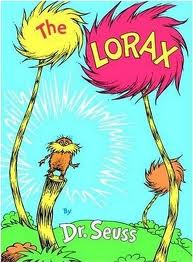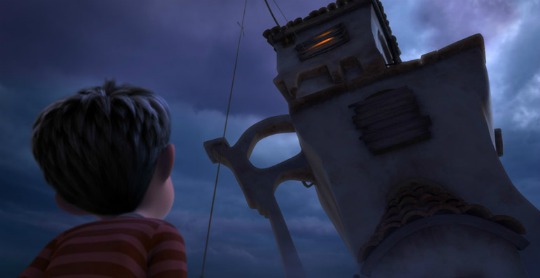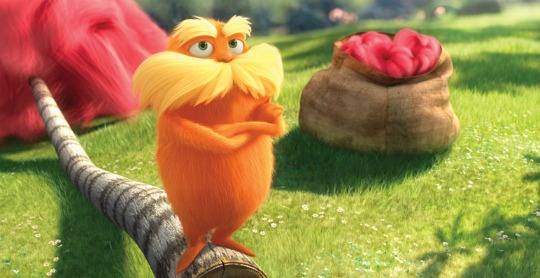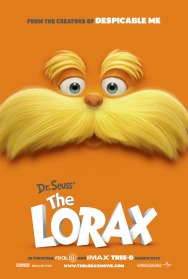Let’s lay all the facts on the table:
- I’m a book lover. Obviously.
- I’m a children’s literature enthusiast, and with over a decade’s worth of experience in preschool classrooms, I’ve read more books aloud than I could even guesstimate.
- I have a top five list of picture books that I adore reading aloud– the ones that I know are sure-fire hits and give me immense pleasure to share.
- I have a history of disappointment with movie adaptations of books that I hold dear, and I’ve never been afraid of sharing my opinion.
 When it comes to the soon-to-be-released film The Lorax, I can honestly report that I had my misgivings. Dr. Seuss’ The Lorax just happens to be on that top five list of my favorites, and I know that I knock the socks off kids when I read that one aloud.
When it comes to the soon-to-be-released film The Lorax, I can honestly report that I had my misgivings. Dr. Seuss’ The Lorax just happens to be on that top five list of my favorites, and I know that I knock the socks off kids when I read that one aloud.
Two weeks ago, I had the incredible opportunity to attend a pre-screening of the movie, and I was terribly concerned that I’d come back from a fabulous trip not excited to talk about the film if one of my favorite pieces of classic children’s literature had been butchered. Well, I’m thrilled to be able to report no disappointment whatsoever!
Going from the page to the screen

The plot of the book remains central in the movie version, and an additional back story is created to explain just why the boy (unnamed in the book, but given the name Ted in the movie after Dr. Seuss himself) is heading out beyond town to talk to the Once-ler in the first place. What motivates a twelve year old boy better than a romantic crush? Audrey, the girl of his dreams, residing in the artificially-perfect town of Thneedville along with him, knows about the things called trees that used to grow. All Audrey wants is to see a real tree. Ted, hoping to please her, follows the advice of his grandmother in seeking out the Once-ler, setting the stage for the beginning of the story as told in the book.

The spirit of the book is retained in the theatrical telling of it, even while screenwriters Cinco Paul and Ken Daurio did expand on the story to transform it into a 94 minute film. Though characters and scenarios are invented that did not exist in the original book, the writers did it in a truly seamless way, in my opinion. And remember, I’m a purist at heart! Seriously, the world created in the movie The Lorax is a perfect Dr. Seuss representation, from the design of the buildings in Thneedville to small details like the old crows who fly over the Street of the Lifted Lorax. (Remember, it’s where “no birds ever sing excepting old crows,” after all.)
The world of Dr. Seuss
For keen observers who have a solid background of Seussian knowledge and experience, you’ll even notice that two minor characters in the film are named “Mooney” and “McGurk,” familiar names from other Dr. Seuss classics. I asked the screenwriters Cinco Paul and Ken Daurio who I should credit with that incredibly wise decision, most especially because one of them shares my own last name. It’s Ken Daurio who I have to thank for that!
Daurio: “What we did when we started was we said we’re going to go into that town. In the book, there’s a little picture in the background, and that’s all there is. That’s all we had to go off of. And so, it’s like, well, what does that town really look like? So, what we did was assembled all the books. We got images from every book. And we did that with names, also. And so, we just thought anywhere we can go into his world and find names or images or things that’ll support our story, that’s what we did.”
The best thing I can tell you, beyond reassurances that the screenwriters, along with producer Chris Meledandri and director Chris Renaud, did right by Dr. Seuss’ beloved story is that one of the executive producers was Audrey Geisel, Theodor “Dr. Seuss” Geisel’s wife, arguably the person who speaks best for his work and intent now that he is no longer with us.
Meledandri: “Audrey, who executive produces this film, is a very important part of the process. Whenever you have a body of work that has creative expressions over time, it is really important for somebody to be the keeper of the integrity of the original intent. And a lot of that falls to Audrey. But, she is involved from the ideas about story expansion to the translation of character designs into dimensional designs, to in this case, the color palette, because in this book, Ted Geisel, Dr. Seuss, used different colors than he had used in his body of work. And that was something that she was very involved with him in those discussions. So, there’s a whole range of areas where she is very forthright and gives input consistently.”
 In the last two weeks, The Lorax (the book) has had a resurgence in popularity for our reading at home, and I’ve had the great pleasure of reading it to both my own preschool class and my daughter’s kindergarten class. There’s been much talk about the upcoming movie, and I’ve been emphasizing the importance of remembering the original material even while enjoying a new take on it in movie form. That being said, my own children are uber-excited to see it, and I’m looking forward to watching it again with them.
In the last two weeks, The Lorax (the book) has had a resurgence in popularity for our reading at home, and I’ve had the great pleasure of reading it to both my own preschool class and my daughter’s kindergarten class. There’s been much talk about the upcoming movie, and I’ve been emphasizing the importance of remembering the original material even while enjoying a new take on it in movie form. That being said, my own children are uber-excited to see it, and I’m looking forward to watching it again with them.
If you haven’t seen the trailer, check it out below. (I’m pretty sure you’ve all seen the trailer, but enjoy it again. I’ve watched it about a bazillion times now!) The film opens in theaters on Friday, March 2, what would have been Theodor Geisel’s 108th birthday. Celebrate it at the theater with your kids!
In the next few days, I’ll happily be sharing with you my experiences during the round-table interviews with some of the voices behind the characters in The Lorax over on 5 Minutes for Mom. We’re talking Ed Helms, Rob Riggle, Danny DeVito, and the incomparable Betty White. Yes, the Betty White. (And I cried. Just wait until you hear the whole story.)
For more of my thoughts on the translation of this classic book to the screen, please see my part two of Books on Screen: More on Dr. Seuss’ The Lorax.
Check out The Lorax on Facebook! Watch clips, play games, get free mobile downloads and download printables.
Dawn has strong opinions on lots of things, books and movies high on that list. She’s happy when those opinions are positive, since people seem to like hearing those more than the negative ones. She can be found hanging out online on her blog, my thoughts exactly.
Great review! I so want to see this. I’m a huge fan of Dr. Seuss books.
I can’t wait to hear the general reception of this movie when it opens. Everyone in our group really enjoyed it!
Wonderful review! I am looking forward to seeing it next weekend.
Thanks, CM! I’m so excited to take the kids to see it. My daughter has asked a friend from school to join us, so we’ll have a crew. 🙂
The Lorax wasn’t ever one of my Seuss faves, but the movie looks great (if a tiny bit preachy), and the kids are both dying to see it.
What I did appreciate was the point that the movie makes, perhaps stronger than the book, about the emphasis on sustainability. We can’t say that we NEVER have reason to cut down a tree, but planting more and sustaining their health is an important thing.
I can’t wait to hear what folks think after they see it!
I, too, think both the book and the movie are a bit preachy. At the same time, I think it’s important not to waste what we’ve been given. Certainly we’re called to steward things well. This isn’t a favorite of mine but we have been very curious about it!
Thanks for sharing where the movie deviates from the book. I think it’s extremely cool that his wife has played such a huge role in bringing this book to the screen. That’s very neat!
I gotta say that I find this perspective interesting, as I personally think “preachy” is something quite different.
And yes, hearing about Audrey’s role in the production really reassured me. She had final approval on everything, and I’m satisfied when she says she thinks Ted would be very proud of the final product. 🙂
I think that anything — especially a work of fiction — that puts forth a strong message could be called “preachy.” That’s my interpretation, and probably Carrie’s too.
So even if it’s a valid message, when there’s a message put forth, *I* think it can be called preachy. LOTS of movies/books do a little preaching 🙂
But, “preachy” carries a negative connotation, right?
It does. I get that. But I guess as I was formulating the response, I thought about it. I think when anything fiction has a strong message about morals, or ideology, it’s intentional, so thus a bit preachy.
That said, this definition at dictionary.com is a bit preachy itself, and definitely NOT what I meant: tediously or pretentiously didactic.
I’m not sure if you are an NPR lover like me, but I just heard David Edelstein’s review of this movie on Fresh Air and I thought you might be interested to hear his viewpoint.
http://www.vulture.com/2012/03/movie-review-the-badness-of-the-lorax-is-a-shock.html
or
http://www.npr.org/2012/03/02/147573582/the-lorax-a-campy-and-whimsical-seussical
Wow, Barb, what an article!! I find it interesting that Edelstein doesn’t address the fact that Audrey Geisel was involved at the highest levels in this film. I trust her opinion when she states that Ted would have loved the film, and I personally have to disagree with the statement that the film loses its “Suessian” feel. To each his own, I guess. 🙂
I did note this sentence in the review:
Dr. Seuss’s The Lorax [sic] isn’t as eyeball-searing as the live-action Mike Myers monstrosity The Cat in the Hat, which even Geisel’s injudicious widow Audrey found repulsive, compelling her to pull the plug on any future live-action Seuss adaptations.
And of course, to each their own! I haven’t even seen the movie, so I don’t have an opinion on it yet. But when I heard the review on NPR I thought, “I have to share this with Dawn.” (How much of a geek am I?!)
Not a geek at all?? For years, while I was a stay-at-home-mom and more prolific blogger, I used to recap my favorite NPR stories from the week every Wednesday. So, you found the right person to geek out to NPR with! 🙂